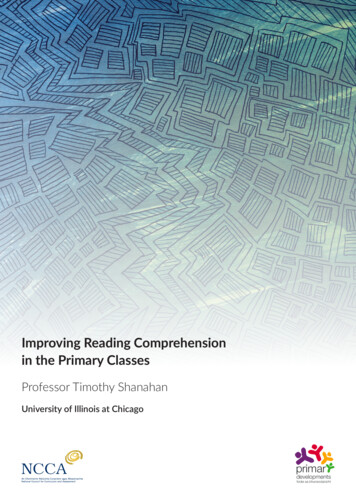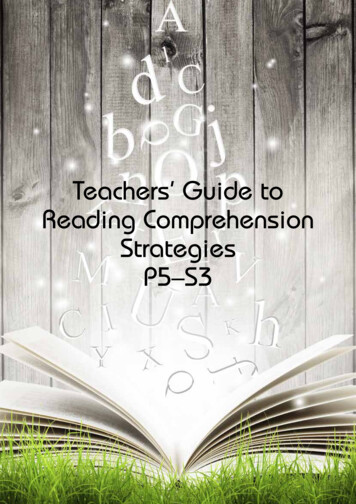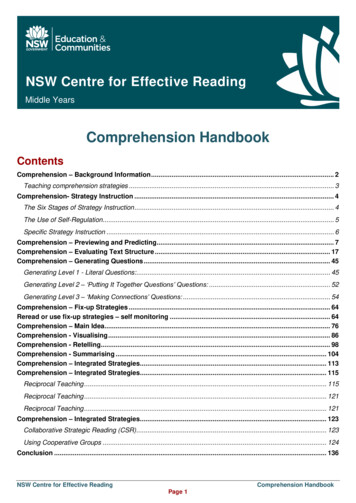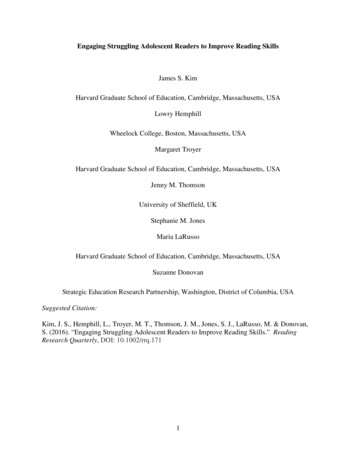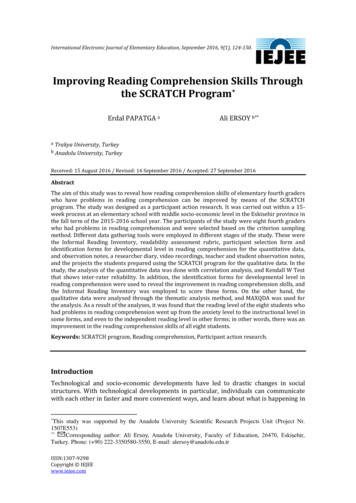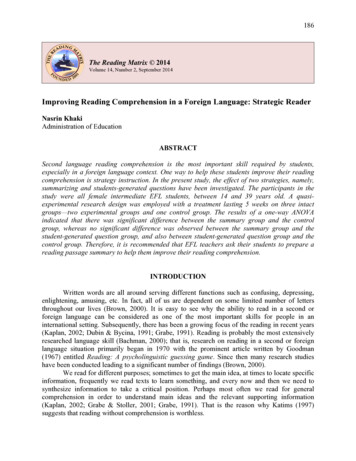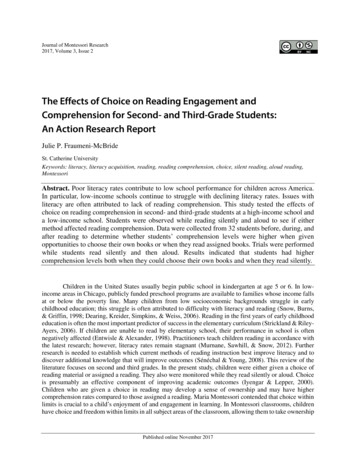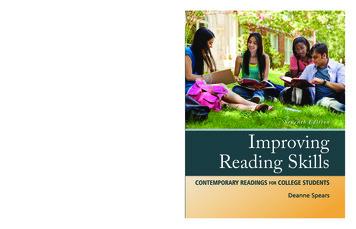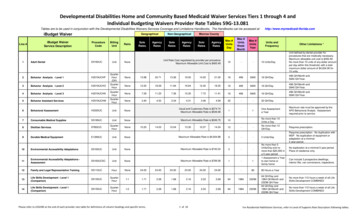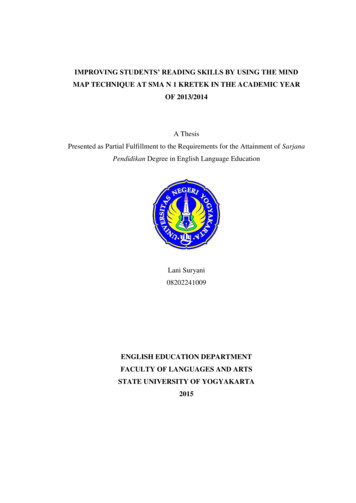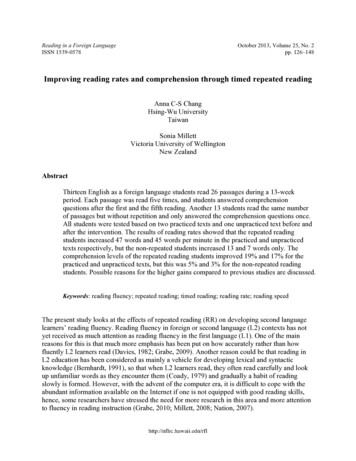
Transcription
Reading in a Foreign LanguageISSN 1539-0578October 2013, Volume 25, No. 2pp. 126–148Improving reading rates and comprehension through timed repeated readingAnna C-S ChangHsing-Wu UniversityTaiwanSonia MillettVictoria University of WellingtonNew ZealandAbstractThirteen English as a foreign language students read 26 passages during a 13-weekperiod. Each passage was read five times, and students answered comprehensionquestions after the first and the fifth reading. Another 13 students read the same numberof passages but without repetition and only answered the comprehension questions once.All students were tested based on two practiced texts and one unpracticed text before andafter the intervention. The results of reading rates showed that the repeated readingstudents increased 47 words and 45 words per minute in the practiced and unpracticedtexts respectively, but the non-repeated students increased 13 and 7 words only. Thecomprehension levels of the repeated reading students improved 19% and 17% for thepracticed and unpracticed texts, but this was 5% and 3% for the non-repeated readingstudents. Possible reasons for the higher gains compared to previous studies are discussed.Keywords: reading fluency; repeated reading; timed reading; reading rate; reading speedThe present study looks at the effects of repeated reading (RR) on developing second languagelearners’ reading fluency. Reading fluency in foreign or second language (L2) contexts has notyet received as much attention as reading fluency in the first language (L1). One of the mainreasons for this is that much more emphasis has been put on how accurately rather than howfluently L2 learners read (Davies, 1982; Grabe, 2009). Another reason could be that reading inL2 education has been considered as mainly a vehicle for developing lexical and syntacticknowledge (Bernhardt, 1991), so that when L2 learners read, they often read carefully and lookup unfamiliar words as they encounter them (Coady, 1979) and gradually a habit of readingslowly is formed. However, with the advent of the computer era, it is difficult to cope with theabundant information available on the Internet if one is not equipped with good reading skills,hence, some researchers have stressed the need for more research in this area and more attentionto fluency in reading instruction (Grabe, 2010; Millett, 2008; Nation, 2007).http://nflrc.hawaii.edu/rfl
Chang & Millett: Improving reading rates and comprehension127Fluency in the Reading ProcessReading fluency has been defined as readers having the ability “to read text rapidly, smoothly,effortlessly, and automatically with little attention to the mechanics of reading such as decoding”(Meyer, 1999, p. 284), and the ability to combine information from various sources whilereading under fairly intense time constraints (Grabe, 2010, p. 72). Reading fluency also dependson maintaining a good reading speed for long periods of time and on generalising across texts(Hudson, Lane, & Pullen, 2005). It seems that a general consensus of reading fluency comprisesthree primary components: automaticity in word recognition, accuracy in decoding, and rapidreading rates (Kuhn & Stal, 2003, Grabe, 2009). These components in reading processing areclosely linked with one another. However, the role of automatic word recognition is consideredthe foundation or heart of fluent reading (Segalowitz & Hulstijn, 2005), and is assumed to arisefrom constant and regular practice. Accuracy in decoding words or texts is another essentialcomponent in reading fluency. Without accuracy in decoding words and text, comprehension islikely to become degraded. These two processes must occur at a reasonable speed throughout anextended text. On the whole, a high level of reading comprehension is not possible withoutautomatic and accurate word recognition of a large amount of vocabulary at a rapid rate.Well-established reading research indicates that reading involves lower- and higher-levelcognitive processes (cf. Grabe, 2009; Perfetti, 1999; Pressley, 2006). Lower-level processes referto word recognition, syntactic parsing, meaning proposition encoding and working memoryactivation (Anderson, 2000; Koda, 2005). All of these are fundamental elements and they mustbe processed rapidly and automatically. With the automation of these low-level skills, readers areable to devote their attention to higher-level processes (LaBerge & Samuels, 1974), such asdrawing on background knowledge, using strategies to understand text meaning, interpretingideas, making inferences, and evaluating the information being read. While one is reading, thetwo processes are posited to support each other rather than working serially.Reading Rate and ComprehensionFor L2 readers, lower-level processing seems to be more problematic than higher-levelprocessing because these readers are unable to carry out lower-level processing in an efficientway (Grabe, 2009). According to Carver (1982), the optimal silent reading rate for L1 universitystudents is between 250 and 300 words per minute (wpm), but this depends on the purpose of thereading, normally 300 wpm for rauding (a combination word from reading and auding, meaningjust to understand the message), 200 wpm for learning, and 138 wpm for memorizing (Carver,1982). However, many L2 university students read well below these figures (Fraser, 2007;Nation, 2005), at around 100-150 wpm. This is further supported by recent empirical readingfluency studies (Chang, 2010, 2012; Chung & Nation, 2006; Gorsuch & Taguchi, 2008;Macalister, 2010; Yen, 2012). The inefficiency of low-level processing may prevent L2 readersfrom using cognitive resources for meaning construction (Grabe, 2009). Because of this,assisting L2 readers to develop low-level processing seems to be key to turning them intoeffective readers.Good reading fluency usually also indicates a high level of comprehension and some statisticalReading in a Foreign Language 25(2)
Chang & Millett: Improving reading rates and comprehension128indices have confirmed this claim. According to Fuchs, Fuchs, & Hosp (2001), correlationsbetween oral reading fluency and comprehension are reported as high r .81 to .90. Anothermeta-analysis study based on 99 comparisons by the U.S. National Reading Panel (NRP, 2000)also shows a moderate effect size of .41. The above discussion of fluency is based on L1 settings.In L2 reading research, faster reading rates seem to come at the expense of comprehension or theother way around. For example, Cushing-Weigle & Jensen (1996) found that their students’reading rate improved about 40 wpm, from 158 to 195, but their comprehension scores decreasedfrom 6.59 to 5.80 out of 10. Chang’s (2010) study, however, showed that students’ reading rateimproved without deteriorating comprehension but the comprehension level remainedunsatisfactory, at only 67%. Similar results were found in the studies by Taguchi and hisassociates (1997, 2002, 2004) and Gorsuch and Taguchi (2008). Research by Chang (2012),however, is rare in that it demonstrates improved reading rates also enhancing comprehensionlevels. Some studies only focused on reading rates and did not include students’ readingcomprehension levels (Chung & Nation, 2006; Macalister, 2008, 2010). If comprehension is notassessed, learners may simply scan a text. For example, Just & Carpenter (1987) reported that L1readers could skim a text at 600-700 wpm but could understand no more than the gist of thepassage. This highlights how purpose can affect reading rates and comprehension (Carver, 1990).Nation (2005) notes that for silent reading speed practice, readers should comprehendapproximately 70% to 80%, if not, learners should slow down and read more texts at the samelevel until comprehension improves. How to balance speed and comprehension is of importancein L2 reading instruction. Due to the scant and inconclusive evidence concerning reading ratesand comprehension levels in L2 studies, more research involving reading comprehension inrelation to reading rates is needed.Approaches to Improving Reading RatesThere are a number of approaches that have been found to be effective in helping L1 readersimprove their reading rates. These include oral reading - oral translation of text with speed andaccuracy (see Fuchs et al, 2001; Kuhn & Stahl, 2003 for comprehensive reviews), reading whilelistening—reading assisted with oral rendition of the text (Beers, 1998; Carbo, 1978; Rasinski,1990), timed reading—calculating reading time or reading within a specific time limit (Breznitz& Share,1992; Meyer, Talbot, & Florencio,1999; Walczyk, Kelly, Meche, & Braud, 1999),extensive reading—reading a large quantity of books within readers’ language competence(Krashen, 2004 ; Stanovich, 2000), and repeated reading—rereading short passages severaltimes until a satisfactory rate is reached (see NRP, 2000; Kunh & Stahl, 2003 for extensivereview). As previously mentioned, fluency remains at the developing stage in the L2 learningcontext, so little is confirmed about whether these approaches are beneficial to L2 learners. Forexample, Chang (2012) compares the effects of oral rereading and timed reading on EFLlearners’ reading rate improvement and found that oral rereading had a smaller effect than timedreading on enhancing L2 learners’ reading fluency development. More importantly, and differentfrom L1 studies, Chang’s students did not consider oral rereading an approach to improve silentreading fluency but mainly to improve their oral production and pronunciation. Taguchi andassociates (1997, 2002, 2004) conducted a series of repeated reading studies with Japanesecollege students, but only small effects were found across the three studies, which are somewhatcontradictory to those studies with native English speakers. Inspired by the studies of TaguchiReading in a Foreign Language 25(2)
Chang & Millett: Improving reading rates and comprehension129and his associates on repeated reading with Japanese students, the present study thus intends toextend RR to a different L2 learning context to look at whether repeated reading has strongeffects on reading fluency by using different study materials and treatment procedures.Effects of RR in an L1 ContextRR was originally developed by Samuels (1979) as a remedial approach for L1 children whohave reading difficulties. It consists of “rereading a short, meaningful passage several times untila satisfactory level of fluency is reached” (Samuels, 1979, p. 404). The theory underlying RR isbased on the Laberge-Samuels’ (1974) model of automatic information processing, in which afluent reader decodes texts automatically. If too much effort is paid to decoding word meanings,then little remains for overall meaning construction. Therefore, RR is used as a means to assistunskilled readers to practice the lower-level processing elements. The practice procedure may bevaried in a number of ways, for example RR may be practiced orally or silently, or with orwithout modeling. In addition, the modeling may be live, such as listening to a teacher readingaloud, or, pre-recorded.Research into RR has demonstrated substantial empirical evidence on its effects on developingoral reading fluency in an L1 context, the results of which have been extensively reviewed byChard et al. (2002), Fuchs et al. (2001), Kuhn and Stahl (2003), NRP (2000), and Rasinski andHoffman (2003); however, selective findings that are relevant to the present study aresummarized below:1. Repeated reading has been generally found to be effective in promoting studentreading rates and comprehension (Carver & Hoffman, 1981; Rashotte & Torgesen,1985; Young, Bowers, & Mackinnon, 1996), but RR with assistance (e.g., listening toteacher’s reading aloud or prerecorded oral rendition of the texts) tends to be moreeffective than without it (Rose, 1984; Rose and Beattie, 1986; Smith, 1979).2. Rereading helped students with reading difficulties break out of word-by-word readingto reading larger chunks of meaningful phrases (Dowhower, 1987).3. Mixed effects have been shown for the reading rate and accuracy gained fromrereading passages being transferred to new or unpracticed passages (Carver andHoffman, 1981; Faulkner & Levy, 1994; Herman, 1985; Rashotte & Torgesen, 1985).4. Reading small quantities of texts repeatedly did not show any better effect thanreading a large amount of texts without repetition (Kuhn, Schwanenflugel, Morris,Morrow, Woo, Meisinger, Sevcik, Bradley, & Stahl, 2006; van Bon, Boksebeld, FontFreide, & van den Hurk, 1991), so to enhance the effectiveness of RR, readers have toread a series of texts for a period of time (Dowhower, 1987).5. Whether the effects of RR came from instructional features or increased exposure toprint are unclear (Kuhn and Stahl, 2003).Effects of RR in an L2 ContextThe use of RR to improve reading fluency in the teaching of L2 is more limited (Taguchi,Gorsuch, & Sasamoto, 2006). In an English as a foreign language (EFL) context, Taguchi andhis associates conducted a series of studies with Japanese college students on the effects of RRReading in a Foreign Language 25(2)
Chang & Millett: Improving reading rates and comprehension130on reading fluency (1997; Taguchi & Gorsuch, 2002; Taguchi, Takayasu-Maass, & Gorsuch,2004). Their studies are summarized in Table 1. As shown in Table 1, treatment materials usedfor RR were graded readers divided into different lengths of segments, ranging fromapproximately 300 words to 600 words. Students were asked to read the segments five or seventimes. In their first three studies, the overall results show that reading rates and comprehensionlevels at the end of the study showed no statistically significant difference between the RR groupand the NRR group. No transfer effect was found across the three studies. Despite there beingsome reasons pointed out by the researchers themselves regarding the not so encouraging results,one of the main reasons could be the pretest, posttest, and treatment passages not beingequivalent in difficulty. For example, in the 2002 study, the treatment passages calculated usingthe Flesch-Kincaid reading ease scale were between 4.20 and 4.30; however, the pretest was 6.20,and the posttest 7.20. If so, it is not possible to determine the treatment effects. Another reasoncould be that segmenting a book into several portions and then each segment being read seventimes might have bored the students or even spoiled the pleasure of reading. As well, if studentsforgot the content read previously, they could not possibly understand the scenarios of the story,which might have led to poor comprehension or even loss of interest in reading.Though the above three studies conducted in Japan did not demonstrate that the students whoreceived RR treatment read significantly faster than those who read at their own pace or readextensively, on the whole, students who had RR treatment improved their reading rates morethan those who read without repetitions. However, this limited number of studies is insufficientto conclude that RR has only a small effect on improving reading rates. To extend their RRresearch to other L2 learning contexts, Gorsuch and Taguchi (2008) worked with 50 Vietnamesejunior university students for 9 weeks. Mixed results were found. The RR group increased 55words per minute on the treatment texts (first reading of session 1 and session 16); however, thegain rate was not transferred to the unpracticed passage from another source, and thecomprehension levels were very low, not reaching the suggested 70% satisfactory level (Nation,2005).Table 1. Summary of repeated reading (RR) in L2 contextStudies(by tyMeasuresTaguchi(1997)16 JapaneseUniversitystudents(RR only)Rate &ComprehensionTaguchi &Gorsuch(2002)18 JapaneseUniversitystudents (RR 9 ; CL 9)28 sections taken fromgraded readers: Born toRun, Away Match, andPoor and Rich LittleGirl28 segments taken fromThe Missing Madonnaand Away Match.Reading in a Foreign Language 25(2)Rate &ComprehensionTreatmenttimes perweek/period3 times perweek/10weeksResults3 times perweek/10weeksRR: 40 wpm (113–153)CL: 11 wpm (115–126)Comprehension (shortanswerquestions):maximumscore is 18RR: 1.89 (7.44–9.33)CL: 2.77 (5.67–8.44)RR: 21 wpm (127–148)Comprehension: notavailable
Chang & Millett: Improving reading rates and comprehensionTable 1. continuedTaguchi20 JapaneseTakayasuUniversityMass &students (RRGorsuch 10; ER (2004)10)13142 segments taken fromThe Missing Madonnaand Away Match.Rate,Comprehension&transfer effect3 times perweek/17weeksGorsuch &Taguchi(2008)50VietnameseUniversity(RR 24;CL 26)16 segments taken fromgraded readers: Scandalin Bohemia, The Redhead League, and TheBoscombe LakeMysteryReading speed,Comprehension& transfereffect2 times dents (oralRR 17;TR 18)26 (oral RR) versus 52(TR) 300-wordpassages speciallywritten for developingreading fluencyReading speed,Comprehension,&Transfer effect(all includingdelayedposttests)1 time perweek/13weeksRate:RR: - 3 wpm (85–82)ER:- 17 wpm(81–64)Comprehension(openended questions):maximum score: 16RR: (1.6–3.90)ER: (1.90–4.50)No transfer effectMixed results,Rates (short answerquestions/ recall)RR: -18 (149–131)/ 20(124–144)CL: 1 (122–123)/-2(132–130)Comprehension(shortanswer questions/recall): in %RR: 27 (14–41)/ 16(9–26)CL: 7 (22–29)/ -3(22–19)No transfer effectResultsRates (posttest/delayedposttest)TR: 50 wpm (102–152)/ 45 (102–147)Oral RR: 23 wpm (83–102)/ 19 (83–102)Comprehension (30 re 30Oral RR: 2/30 (16–18)/ 0/30 (16–16)TR: 4/30 (16–20)/ 2/30 (16–18)Note. RR: repeated reading group; CL: control group; ER: extensive reading group; TR: timedreading; oral RR: oral repeated readingThe above studies in two L2 learning contexts show that RR has some facilitative effect onimproving reading fluency, rates varying from 21, 40, -3, and 55 wpm in each study. Thecommon characteristics of these studies were that the treatment passages as well as the pre andposttest texts were segments taken from graded readers. Whether these study materials weresuitable for L2 reading fluency training purposes may have to be reconsidered along with theequality of text difficulty between pre and posttest. Therefore, to address the first issue thepresent study adopts materials that are particularly designed for L2 learners to develop theirReading in a Foreign Language 25(2)
Chang & Millett: Improving reading rates and comprehension132reading fluency. The books that focus on developing reading fluency are written in familiar highfrequency vocabulary to avoid the slowing effect of unfamiliar words. Complicated sentencesand complex noun groups are avoided. Each passage in each level contains approximately equalword counts, which makes it easier for students to calculate and compare their reading speed(personal communication with the first author). There are also five similar passages on eachtopic (e.g., five on animals, five on computers). Each passage is independent from the others, sothe students do not have to worry about forgetting previous content when they read the nextpassage. To avoid the second issue, the same test measure used in the pretest will be reused inthe posttest. Two research questions (RQ) were raised:1. Did students who receive RR treatment read significantly faster than those who didnot receive the RR treatment? If yes, could the rate gained from the intervention betransferred to reading an unpracticed passage?2. Did students who receive RR score higher in their comprehension tests than those whodid not receive the RR treatment? If yes, could the improvement be transferred toreading an unpracticed passage?MethodThe participantsThe participants were 26 eighteen to nineteen years old college students in Taiwan, selected froma class of 40 students for their unfailing attendance throughout the whole treatment period. Allthe participants had received formal and compulsory English instruction for seven years.Students were from different majors but the majority were studying accounting, finance, ortourism. They had only one three-hour English course, meeting once a week with their Englishinstructor, and their learning of English had been limited to the prescribed content – normallycommercially published textbooks were used in the classroom for formal instruction. On the firstmeeting with the researcher, a Vocabulary Levels Test1 (VLT, Schmitt, Schmitt, and Clapham,2001) was administered to the class in order to assess the participants’ high frequency wordknowledge. The overall VLT results were 23, 19 and 10 out of 30 in the 1st, 2nd, and 3rd 1000words respectively, indicating that they might know 1732 individual words[(23 19 10) x33.3],which allowed the researcher to select reading materials appropriate for the students’vocabulary knowledge level.The RR activity was included as a part of the three-hour English course; however, students’participation in repeated reading was fully voluntary. Twenty-two students took part in the RRactivity at the beginning, but nine students either dropped out or were absent from the activityduring the intervention period. The students who did not take part in the RR were classified inthe non-repeated reading (NRR) group. The NRR group read the passages that the experimentalgroup read, recording the time they spent reading each passage, and answering thecomprehension questions, but they did all these activities only once, and then they studied thecontent of their course book for an average of 15 minutes (mainly reviewing the vocabularytaught in the previous session). At the end of the semester, 13 students in each group hadReading in a Foreign Language 25(2)
Chang & Millett: Improving reading rates and comprehension133participated in all sections of the activity, and their performance data were used for this study.Study materialsReading for Speed and Fluency by Nation & Malarcher (2007), Book 1 was adopted for thereading fluency activity. Book 1 is written in expository style in familiar high frequencyvocabulary, approximately at the 500 word level. Each passage is of approximately equal wordcount, 300 words, followed by five multiple-choice comprehension questions. Each question hasthree options and most of the questions focus on global understanding (e.g., the topic of thereading, or the purpose of the passage) rather than detailed information (e.g., specific dates orplaces). There is a total of eight topics (animals, books, computers, music, places, medicine,plants and learning) in the book, each topic contained five passages, forty passages all told in thebook; however, due to the constraint of the treatment period, only 31 passages were used.Amongst the 31 passages, passage 1 was used as RR practice before the pretests, passages 2 & 3as the pretest 1, 4–29, the treatment passages, and 30–31 the posttest 1 (also see the section ondependent measures). The RR group read treatment passages five times in contrast to the NRRgroup reading them only once.Dependent measuresReading rate: Students’ reading rates were measured through two pretests and two posttests(named pretest 1, pretest 2, posttest 1, and posttest 2, hereafter). Pretest 1 was based on the firstreading rates of two passages (passages 2 and 3), and pretest 2 was based on a 2058-word story,The Girl with Green Eyes, taken from a graded reader, One-Way Ticket (Bassett, 2000, OxfordBookworm Series). The purpose of using the 2058-word story was to examine whether students’improved reading rate (if any) can be transferred to reading an unpracticed passage (a text takenfrom a different source than those used in the instructional treatment). Posttest 1 was based onthe first reading rates of the last two passages (passages 30 and 31), and the passage for posttest2 was the same one as in pretest 2. The texts for dependent measures were analysed and found tobe comparable in terms of vocabulary levels, the total percentage of 1000 and 2000 words beingabout 94%, 96%, and 95% for pretest 1, posttest 2, and pretest 2 and posttest 2 respectively (seeTable 2)2. However, the average number of words in each T-unit for the unpracticed passage islower than the average number of words in both pretest 1 and posttest 1, which may suggest thatthe syntactic structure of the unpracticed passage is easier than the practiced ones3. Apart fromvocabulary and syntax, the plot of the unpracticed passage is more complicated, containing morecharacters and many proper nouns, in particular, the names of places. These features maybalance out the shorter length of overall sentences, making the text difficulty of practiced andunpracticed passages more comparable.Reading comprehension: Students’ reading comprehension levels were also measured throughtwo pretests and two posttests. Pretest 1 and posttest 1 contained a total of 10 multiple-choicequestions taken from the original reading materials, five questions from each passage. The 10questions for pretest 1 were based on passages 2 and 3, and another 10 questions for posttest 1from passages 30 and 31. Nineteen multiple-choice questions were constructed by theresearchers for pretest 2 and posttest 2 based on the story The Girl with Green Eyes. The 19questions were piloted twice, each time with six same year students from different classes (thereReading in a Foreign Language 25(2)
Chang & Millett: Improving reading rates and comprehension134were 20 items; one item was deleted after the first piloting). An example of a question in pre andposttest 2 is: Where are these people? Students had to choose from one of four options: on atrain, on a bus, in a cafeteria, and on a boat. A full score was 19 if all the questions wereanswered correctly. The differences between the treatment passage questions and thosedeveloped by the researchers are the density of questions and answer options. There were threeanswer options for the questions taken out from the treatment passages with one question every60 words; however, there were four answer options per question for the questions developed bythe researchers and one question every 108 words.Table 2. Texts analysis for dependent measuresPretest 1Posttest1(passages 2 & 3)(passages 30 & 31)1st 1000502/83.81%568/94.04%nd2 100064/10.68%15/ 2.48%rd3 10002/ .33%3/ .50%Not on the list31/ 5.18%18/2.98%Total words599604Total T-units5448A/W per T-unit11.13 (SD 5.06)12.65 (SD 6.47)Pretest 2 & Posttest 2(The Girl with Green Eyes)1790/86.98%171/8.31%0/0%97/4.71%20582577.80 (SD 4.78)The TreatmentPrior to the treatment, both groups were given specific instructions regarding how to do thereading activity. These specific instructions involved getting themselves ready for the readingactivity (putting away irrelevant things, going to the toilet if necessary, turning cellular phones tothe silent/aviation mode), reading the passages as fast as they could, no referring back to the textsto find answers when they answered questions, and recording the time taken to read each passage.Except the pre and posttests, the students timed themselves using their own cellular phones. Theparticipants were given a RR form (see Appendix A) to record the time they spent reading eachpassage. The form was collected after students finished each treatment and then returned to themthe next time before doing the reading activity. The participants were required to read twopassages each week for 13 weeks, a total of 26 passages all told excluding two for pretest 1 andtwo for posttest 1. The RR group read each passage five times silently, and answered the samecomprehension questions twice, once after the first reading and the other after the 5th reading.The NRR group, however, read each passage silently only once and answered the comprehensionquestions only once. The weekly treatment for each group is outlined as below:The repeated reading (RR) group1. Read passage 1 and timed the 1streading2. Answered the comprehensionquestions for the first time (5 items)3. Read passage 1 and timed the 2ndreadingReading in a Foreign Language 25(2)The non-repeated reading (NRR) group1. Read passage 1 and timed thereading2. Answered the comprehensionquestions (5 items)3. Read passage 2 and timed thereading
Chang & Millett: Improving reading rates and comprehension4. Read passage 1 and timed the 3rdreading5. Read passage 1 and timed the 4threading6. Read passage 1 and timed the 5threading7. Answered the comprehensionquestion a second time8. Read passage 2 and timed the 1streading (then repeated steps 2 to 7)9. Checked answers1354. Answered the comprehensionquestions ( 5 items)5. Checked answers6.Reviewed the content of theircourse bookProcedureIn the first three-hour meeting students were given a vocabulary levels test, followed byinstructions of how to do the RR activity. A practice speed reading exercise (passage 1) wasgiven to students prior to the pretests. Students then read passages 2 and 3 once as pretest 1.They then read The Girl with Green Eyes (the first story in One-Way Ticket, Oxford BookwormSeries, Stage 1) once as pretest 2. An online stopwatch (http://www.online-stopwatch.com/largestopwatch/) was used to record times. The stopwatch was projected onto a screen in front of theclass, so every student could see the time clearly, and all started at the same time when theyheard the command ‘Go.’Starting from the second week, students read two passages following the treatment proceduredescribed above. Students used their cellular phones to measure the time they spent on readingand then recorded it on the separate sheet every week. In the fifteenth week, students readpassages 30 and 31 once, and the average of the two reading rates was averaged (posttest 1)—thereading rate of the practiced passage. The story, The Girl with Green Eyes was also read once(posttest 2)—readin
Improving reading rates and comprehension through timed repeated reading Anna C-S Chang Hsing-Wu University Taiwan Sonia Millett Victoria University of Wellington New Zealand Abstract Thirteen English as a foreign language students read 26 passages during a 13-week period. Each passage
